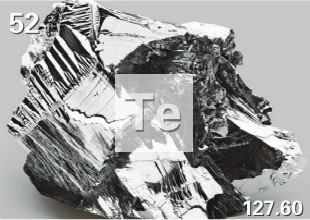Chemical properties of Tellurium
- Atomic number:
- 52
- Atomic mass:
- 127.6 g.mol -1
- Electronegativity according to Pauling:
- 2.1
- Density:
- 6.24 g.cm-3
- Melting point:
- 450 °C
- Boiling point:
- 1390 °C
- Vanderwaals radius:
- 0.137 nm
- Ionic radius:
- 0.221 nm (-2) ; 0.042 nm (+4)
- Isotopes:
- 23
- Electronic shell:
- [ Kr ] 4d10 5s2 5p4
- Energy of first ionisation:
- 869.0 kJ.mol -1
- Standard potential:
- - 0.91 V ( Sb3+/ Sb)
Tellurium is a semimetallic, lustrous, crystalline, brittle, silver-white element. It is usually available as a dark grey powder, it has the properties both of the metals and the non metals. Tellurium forms many compounds corresponding to those of sulfur and selenium. When burned in air tellurium has a greenish-blue flame and forms tellurium dioxide as a result. Tellurium is uneffected by water or hydrochloric acid, but dissolves in nitric acid.
Applications
Tellurium is often used as an additive to steel and it is often alloyed to aluminum, copper, lead or tin. Tellurium is added to lead to improve its durability, strenght and resistence to corrosion. It can be used for cast iron, ceramics, blasting caps, solar panels, chalcogenide glasses. When added to rubber, tellurium speeds up the curing process and makes the product less susceptible to ageing and less likely to be affected by oil, which softens normal rubber.
Tellurium in the environment
Tellurium is present in coal at up to 2 ppm. This is probably the major source of this metal, which can be taken by plants from soil. Tellurium in plants can reach level as high as 6 ppm, although few food plants have more than 0.5 ppm and most have less than 0.05 ppm.
Samples of uncombined tellurium can be sometimes found, but they are extremely rare. There are some tellurium minerals (calaverite, sylvanite, tellurite), but none is mined as a source of the element. World production is around 220 tonnes/year. Major producers are USA, Canada, Peru and Japan. The reserves of this element have not been assessed.
Applications
Tellurium is often used as an additive to steel and it is often alloyed to aluminum, copper, lead or tin. Tellurium is added to lead to improve its durability, strenght and resistence to corrosion. It can be used for cast iron, ceramics, blasting caps, solar panels, chalcogenide glasses. When added to rubber, tellurium speeds up the curing process and makes the product less susceptible to ageing and less likely to be affected by oil, which softens normal rubber.
Tellurium in the environment
Tellurium is present in coal at up to 2 ppm. This is probably the major source of this metal, which can be taken by plants from soil. Tellurium in plants can reach level as high as 6 ppm, although few food plants have more than 0.5 ppm and most have less than 0.05 ppm.
Samples of uncombined tellurium can be sometimes found, but they are extremely rare. There are some tellurium minerals (calaverite, sylvanite, tellurite), but none is mined as a source of the element. World production is around 220 tonnes/year. Major producers are USA, Canada, Peru and Japan. The reserves of this element have not been assessed.



